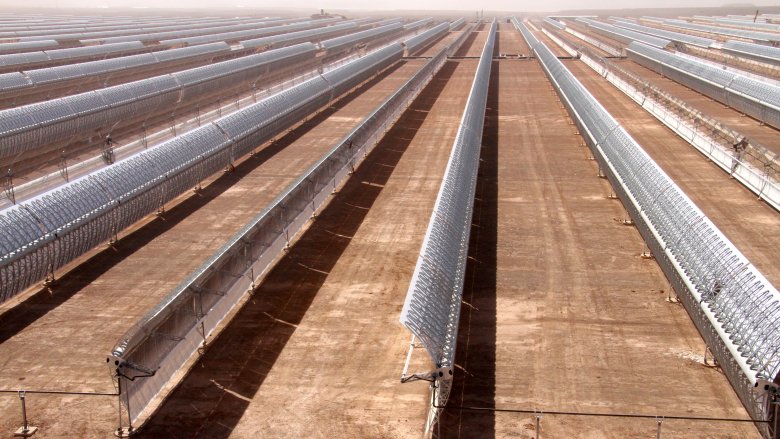 Morocco’s King Mohammed VI switched on the first phase of the world’s largest concentrated solar plant today in the southern town of Ouarzazate. A ceremony was held to officially inaugurate Noor 1 and break ground on the second phase which includes the Noor 2 and 3 projects.
Morocco’s King Mohammed VI switched on the first phase of the world’s largest concentrated solar plant today in the southern town of Ouarzazate. A ceremony was held to officially inaugurate Noor 1 and break ground on the second phase which includes the Noor 2 and 3 projects.
Noor 1 provides 160 megawatts (MW) of electricity for 650,000 local people with power from dawn until three hours after sunset, The Guardian reported.
The final two phases for the project are set to finish construction in 2018. Ultimately, the plant will have a 580 MW capacity and provide energy to more than 1 million people.
The project is called a “concentrated solar plant” because it consists of a large number of movable mirrors that can follow the sun’s path and harness sunlight to melt salt. The molten salt stores energy and can be used to power a steam turbine, allowing for energy production even when the sun isn’t shining.
The plant is aimed at reducing the African country’s carbon emissions. According to a press release from Climate Investment Funds, which provided $435 million to the $9 billion project, “the solar plant underlines the country’s determination to reduce dependence on fossil fuels, use more renewable energy and move towards low carbon development.”
Morocco has been dependent on fossil fuels and imports for nearly 97 percent of its energy, making the solar complex all the more promising.
The World Bank said that the plant will reduce Morroco’s energy dependence by about 2 and a half million tons of oil, and is expected to reduce the country’s carbon emissions by 760,000 tons per year, translating to a reduction of 17.5 million tons of carbon emissions over 25 years.
“With this bold step toward a clean energy future, Morocco is pioneering a greener development and developing a cutting edge solar technology,” Marie Francoise Marie-Nelly, World Bank country director for the Maghreb, said in a statement. “The returns on this investment will be significant for the country and its people, by enhancing energy security, creating a cleaner environment, and encouraging new industries and job creation.”
“It is a very, very significant project in Africa,” Mafalda Duarte, the manager of Climate Investment Funds, told The Guardian. “Morocco is showing real leadership and bringing the cost of the technology down in the process.”
The BBC reported in November that the complex is all part of King Mohammed VI’s plans to turn his country into a renewable energy powerhouse.
“We are convinced that climate change is an opportunity for our country,” environment minister Hakima el Haite told The BBC.
Paddy Padmanathan of Saudi-owned ACWA Power, which is running the thermal project, explained to The BBC that if all goes to plan with the solar plant, Morocco might even be able to export surplus green energy to neighbouring countries.
“If Morocco is able to generate electricity at seven, eight cents per kilowatt, very possible, it will have thousands of megawatts excess,” Padmanabhan said.
“It’s obvious this country should be able to export into Europe and it will,” he added. “And it will not need to do anything at all … it needs to do is just sit there because Europe will start to need it.”
With its endless expanse of sun-drenched deserts, Morocco has the potential to be a solar super power since it has one of the highest rates of solar insolation of any country. The country receives about 3,000 hours of sunshine annually.
Morocco, which will host the next UN climate change conference in November, plans to generate 42 percent of its energy from renewables by 2020, with one-third of that total coming from solar, wind and hydropower, The Guardian reported.
The publication also noted that the solar complex is a springboard for an even more ambitious plan to source 52 percent of its energy from renewables by 2030.

www.ecowatch.com
























